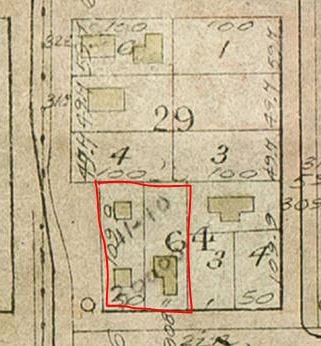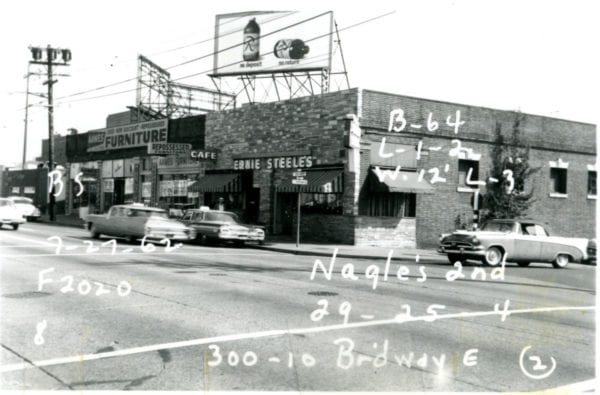Julia’s has become one of the most venerable nightlife spaces in Seattle. The drag-bar-restaurant has been open for 15 years now, and I think you qualify as a Capitol Hill old-timer if you remember further back than that.
The building’s time as Ileen’s and Ernie Steele’s is worth going over again for the newcomers. And hey, it seems the first few decades of the building need to be covered for the first time.
Clik here to view.

300 Broadway East, seen in 1937, carries the modern Julia’s neon sign. Billboards for Parent Teachers Associations, Mobilgas (Mobil Oil), and the film San Francisco starring Spencer Tracy, Clark Gable and Jeanette MacDonald.
In the beginning
The Seattle Public Library’s online 1907 real estate map shows that things were quite different for Julia’s lot. There were just a couple of tiny buildings here along Broadway that didn’t even deserve addresses. There was a house on Thomas Street.
Clik here to view.

Block with Broadway on left, Thomas on bottom in 1907 (Seattle Public Library)
The lots — numbers 1 and 2 of block 64 of Nagle’s Second Addition — were always sold together. The property changed hands several times in the few years prior to the 1907 map, including a three month stint with one buyer before being flipped in November 1906.
The jagged street edge along the east side of Broadway was remarkable. The whole street curved west on the way to Harrison, something like the way Thomas undulates up the hill. Broadway was not straightened out until the 1920s.
The building with Julia’s was constructed in 1909 much as it is today. There were 5 storefronts along Broadway. The north three spaces (now Lifelong AIDS Alliance’s thrift store) had a variety of rotating businesses: a millner (hat shop), tailor, restaurant (with “rendering kettle” written on a 1917 map for making lard from pork fat), an ice cream shop, and others just in the early years.
300 and 302 Broadway were combined into one commercial unit right from the start, and they’re still that way 107 years later. For 30 years it had a series of grocery stores. Then it became a tavern that has morphed for 80 years.
Clik here to view.

The Julia’s and Lifelong Aids Alliance building in 1917. With Ice machine, oven, and lard rendering kettle (Sanborn Fire Insurance map)
Grocers, the first decade
The first tenant of 300 Broadway East was Dodds’ Grocery, owned by brothers John Melville Dodds and Josiah Willson Dodds. They were two of many children of physician Robert Dodds from the outskirts of Topeka, Kansas.
John came to Seattle first, in 1900. Both brothers were grocery store clerks by 1902 and went into partnership with their own store the next year. Initially Dodds’ was on one of the corners of Denny and Boylston.
By the time they moved to the 300 East Broadway building in 1909 they were joined by their siblings Bessie, Samuel, Robert and Mae who worked at the store variously as cashier, clerk or bookkeeper. Their father moved west as well, continuing to work as a physician in Seattle. They all lived near Broadway in homes within a few blocks of the store.
The tight-knit family slowly drifted. First the younger Robert went to teach bookkeeping, penmanship and spelling at Everett High and then for 35 years at Ballard High. Josiah started farming in southeast Washington and then got married and moved in with his in-laws in Illinois.
In 1919 the store broke up. John started a grocery of his own at 10th and Miller. Samuel started a grocery as Dodds & Rutledge in north Wallingford, where the Tangletown Elysian is now.
For just a year 300 East Broadway was owned by grocer C. D. Bridges.
Grocers, decade two
In 1920 Heijiro Hashiguchi took over the space and renamed it the Broadway Sanitary Public Market. Normally a public market would have a number of different businesses in it, but I can’t find any evidence that Hashiguchi’s store was sublet.
Hashiguchi was in Seatte for about a decade working at hotels and groceries before taking over 300 East Broadway, and had his own grocery previously down at 5th and Denny.
I can’t determine what happened to him, his wife Ishi, or his daughter Chiye after 1931. I don’t see them in any Seattle records, the 1940 federal census, or internment documentation from 1942 on.
Admittedly it’s difficult to search for Japanese names in online databases because the transcription is so terrible. Somehow the transcribers know nothing about Japanese names. But I’d expect to see record of them headed to the prison camps. Those records are robust. So I think that Heijiro and Ishi must have returned to Japan.
Grocers, decade three
In 1929 Hashiguchi took on a partner, Ichisuke Imayanagita, and changed the name of the business to Progressive Grocery. Heijiro, Ishi, and Ichisuke’s wife Nobuko were all born in the same area of Japan, Kagoshima, perhaps explaining their connection. After the Hashiguchis left, Imayanagita ran Progressive Grocery until 1936.
Clik here to view.

Former Progressive Market space for lease in 1937 (State Archives property card for parcel 600350-2080)
I hope to pull together the story of the Imayanagita family for an upcoming installment of Re:Take. But to sum it up, Ichisuke Imayanagita followed one of the typical paths of Japanese immigrants to Seattle from the early 1900s.
First he worked in lumber camps in the late teens (lumber, farming, and mercantile work were the three big trades for Japanese). Then he returned to Japan and was wed to Nobuko (some men had brides who joined them for arranged marriage and were wed immediately upon arrival).
He worked long hours in menial jobs until he was a merchant with his own store. And he raised children who learned more in school than he ever had the opportunity for himself.
In 1936 Imayanagita left the grocery business and leased the Trenton Hotel on the west corner of 4th and Columbia (now a parking lot).
A new beginning
The King County assessor photo from early 1937 shows a “For Lease” sign on the side of the building. The front advertised that the space could be subdivided for stalls.
Instead, it was remodeled by a group of partners into a tavern named the Checkerboard which opened in early 1938. As a gimmick the owners brought in a doozy of a special guest in April 1938. Here’s how the Seattle Times put it:
Willie Ryan, the “Bronx Comet” from New York, labeled the world’s greatest profesional checkers player, will appear in a Seattle exhibition… He will meet, blindfold[ed], ten or more of the best players in the Seattle district.” (April 3, 1908 Seattle Times)
Willie Ryan won the national checkers championship the next year, presumably without a blindfold.
The partners were bought out by a group including NFL player Ernie Steele in about 1945. Ernie, a former Highline High and UW star, played DB and halfback for the Philadelphia Eagles for seven years from 1943.
When the Eagles won the title in 1948 he was perhaps Seattle’s first NFL champion. It was the first televised championship game and you can actually watch highlights online. Look for white jersey #37. He makes an interception to seal the win at 14:00 in the video.
After Ernie retired he took over the tavern. The name slowly changed from Checkerboard Cafe to Ernie Steele’s Checkerboard Restaurant to simply Ernie Steele’s. For five decades Ernie Steele’s was a smoky, trustworthy, homey dive. It’s remembered as Seattle’s first sports bar because there was always a game on.
Clik here to view.

Ernie Steele’s, 300 Broadway E, 1962 (Washington State Archives King County property records, parcel 600350-2080)
The next century
Ileen Schumaker bought out Steele in 1991 1993 and rechristened it Ileen’s Sports Bar. She kept an area dedicated to her predecessor, the Ernie Room.
Ileen’s lasted a full decade before the changing face of Broadway priced her out.
Julia’s brought drag shows to 300 Broadway East in 2001 when it opened its third branch in Ileen’s wake. It’s quite a departure from the building’s first few decades as a grocery or the next six as a “dark, old funky bar”.
But that’s the best part. On the 1937 property card, back when the grocery’s time was done, the assessor wrote in “Future Life: 33 years”. They thought it would last 60 years total. The building is 107 years old now, and it still looks great.
Hopefully Julia’s remodel and updated business plan is successful. If not, they’ll rework it again. Eventually just like Ernie Steele’s the decades will roll by and Julia’s will be left to the memory of old-timers.
What new, surprising life will 300 Broadway East have next?